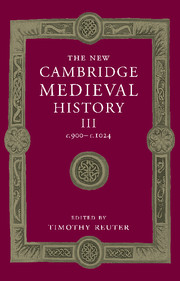Book contents
- Frontmatter
- 1 Introduction: reading the tenth century
- PART I GENERAL THEMES
- PART II POST-CAROLINGIAN EUROPE
- PART III NON-CAROLINGIAN EUROPE
- 19 European Russia, c. 500–c. 1050
- 20 Bohemia and Poland: two examples of successful western Slavonic state-formation
- 21 Hungary
- 22 Byzantium in equilibrium, 886–944
- 23 Bulgaria: the other Balkan ‘empire’
- 24 Byzantium expanding, 944–1025
- 25 Byzantium and the West
- 26 Southern Italy in the tenth century
- 27 Sicily and al-Andalus under Muslim rule
- 28 The Spanish kingdoms
- Appendix genealogical tables
- List of primary sources
- Bibliography of secondary works arranged by chapter
- Index
- Frontispiece
- Plate section
- Map 2: Archbishoprics and bishoprics in the early eleventh century
- Map 4: Germany
- Map 13: Byzantium in 1025
- References
28 - The Spanish kingdoms
from PART III - NON-CAROLINGIAN EUROPE
Published online by Cambridge University Press: 28 March 2008
- Frontmatter
- 1 Introduction: reading the tenth century
- PART I GENERAL THEMES
- PART II POST-CAROLINGIAN EUROPE
- PART III NON-CAROLINGIAN EUROPE
- 19 European Russia, c. 500–c. 1050
- 20 Bohemia and Poland: two examples of successful western Slavonic state-formation
- 21 Hungary
- 22 Byzantium in equilibrium, 886–944
- 23 Bulgaria: the other Balkan ‘empire’
- 24 Byzantium expanding, 944–1025
- 25 Byzantium and the West
- 26 Southern Italy in the tenth century
- 27 Sicily and al-Andalus under Muslim rule
- 28 The Spanish kingdoms
- Appendix genealogical tables
- List of primary sources
- Bibliography of secondary works arranged by chapter
- Index
- Frontispiece
- Plate section
- Map 2: Archbishoprics and bishoprics in the early eleventh century
- Map 4: Germany
- Map 13: Byzantium in 1025
- References
Summary
the kingdom of león (910–1037)
The Arab conquest of most of the Iberian peninsula in 711 destroyed the centralising governmental structures of the Visigothic monarchy and of the Spanish church. One of the first beneficiaries of this was the small kingdom that developed from c. 718 onwards in the northern mountains. This Asturian realm aggrandised itself primarily at the expense of its Galician and Basque neighbours until it was able to extend itself southwards on to the plateau of the Meseta. This southwards shift of the frontier which occurred during the second half of the ninth century led to a comparable displacement of the political centre of gravity, symbolised by the transfer of the main royal residence and administrative centre from Oviedo in the Asturias to the former Roman legionary settlement of León.
The deposition of Alfonso III of the Asturias by his son García (910–913/14) in 910 marks the formal divide between the Asturian and Leonese monarchies, but there was no break in dynastic continuity. Even the transfer of the principal seat of royal government from Oviedo to León may not have taken place before the reign of the second of Alfonso’s sons, Ordoño II (913/14–924). This move was a sign of a greater sense of security, in that the new site was more vulnerable to attack from the Arab-ruled south. However, the dissolution of the central power of the Umayyad amirate of Córdoba during a period extending from the 880s to the 920s must have made such a danger seem increasingly remote. At the same time, the political and economic importance of the rapidly expanding southern frontier districts of the former kingdom of the Asturias made the removal of the centre of royal authority to a site closer to and better placed to supervise those regions increasingly desirable.
Keywords
- Type
- Chapter
- Information
- The New Cambridge Medieval History , pp. 670 - 691Publisher: Cambridge University PressPrint publication year: 2000
References
- 1
- Cited by

